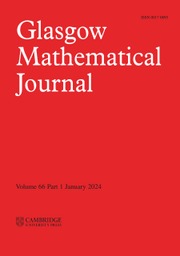Article contents
Square roots of hyponormaloperators
Published online by Cambridge University Press: 01 October 1999
Abstract
An operator$T\in$[Lscr]$(H)$ is called a square root of a hyponormaloperator if $T^2$ is hyponormal. In this paper, we prove the followingresults: Let $S$ and $T$ be square roots of hyponormaloperators.
(1) If $\sigma(T)\cap[-\sigma(T)]=\phi$ or {0}, then$T$ is isoloid (i.e., every isolated point of $\sigma(T)$ is aneigenvalue of $T$).
(2) If $S$ and $T$ commute, then $ST$ is Weylif and only if $S$ and $T$ are both Weyl.
(3) If$\sigma(T)\cap[-\sigma(T)]=\phi$ or {0}, then Weyl's theorem holds for$T$.
(4) If $\sigma(T)\cap[-\sigma(T)]=\phi$, then $T$ issubscalar. As a corollary, we get that $T$ has a nontrivial invariantsubspace if $\sigma(T)$ has non-empty interior. (See[3].)
Information
- Type
- Research Article
- Information
- Copyright
- 1999 Glasgow Mathematical Journal Trust
- 5
- Cited by

